Disaster Management: Post-Disaster Humanitarian Relief Report Analysis
VerifiedAdded on 2020/12/09
|13
|4219
|190
Report
AI Summary
This report provides a detailed analysis of disaster management, specifically focusing on post-disaster humanitarian relief efforts. It explores the concept of disaster management, the role of sovereign countries, and the impact of international organizations like the WHO and Red Cross. The report examines the relationship between post-humanitarian relief work and the disaster management cycle, including preparedness, response, and recovery phases. It also critically analyzes the synergies between disaster management and Disaster Risk Reduction (DRR), highlighting the importance of anticipating and reducing risks. Furthermore, the report evaluates the key principles, strengths, weaknesses, and challenges associated with International Disaster Response Laws (IDRL), assessing their effectiveness in practice. The analysis covers various aspects of post-disaster humanitarian relief, emphasizing the need for coordinated efforts and effective policies to mitigate the impact of disasters and support affected communities.
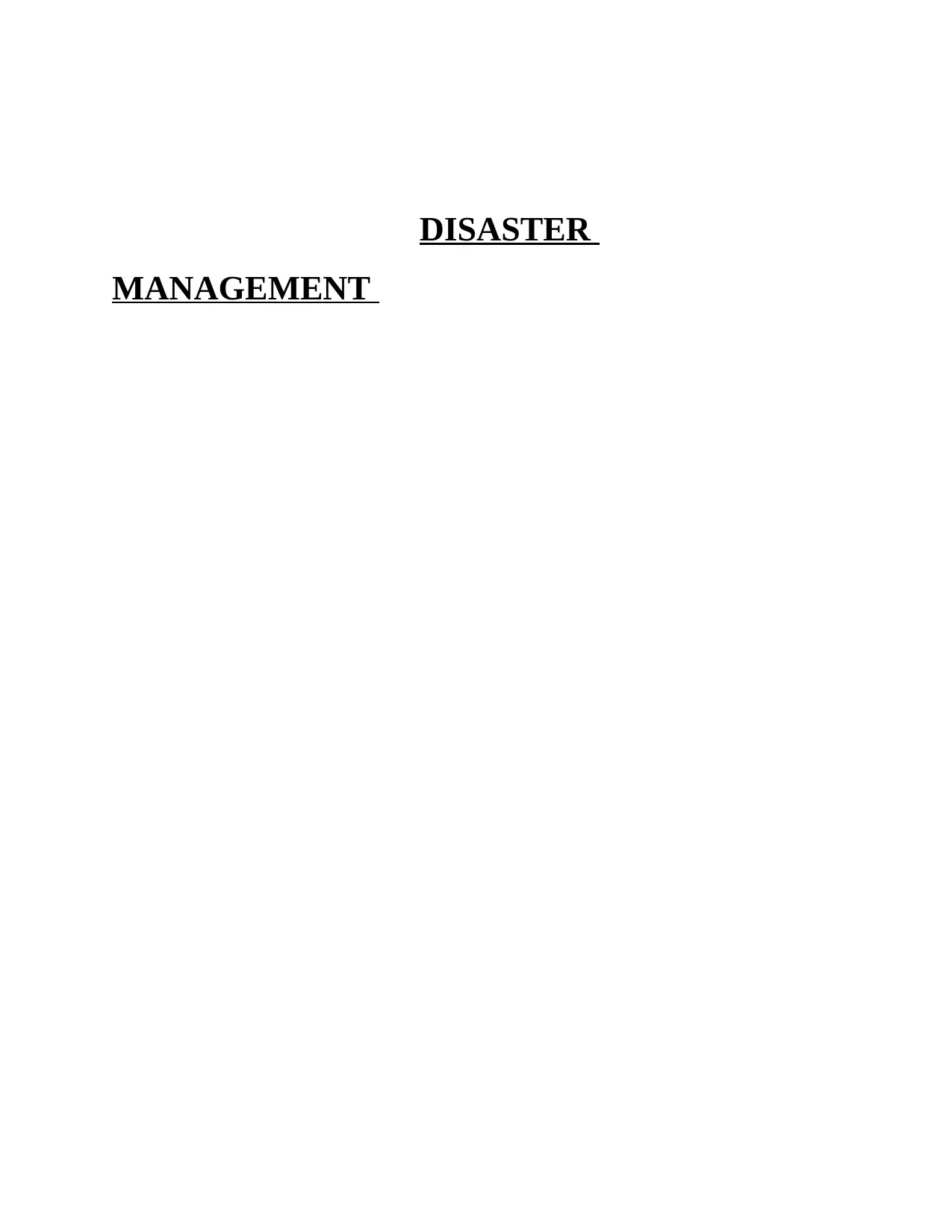
DISASTER
MANAGEMENT
MANAGEMENT
Paraphrase This Document
Need a fresh take? Get an instant paraphrase of this document with our AI Paraphraser
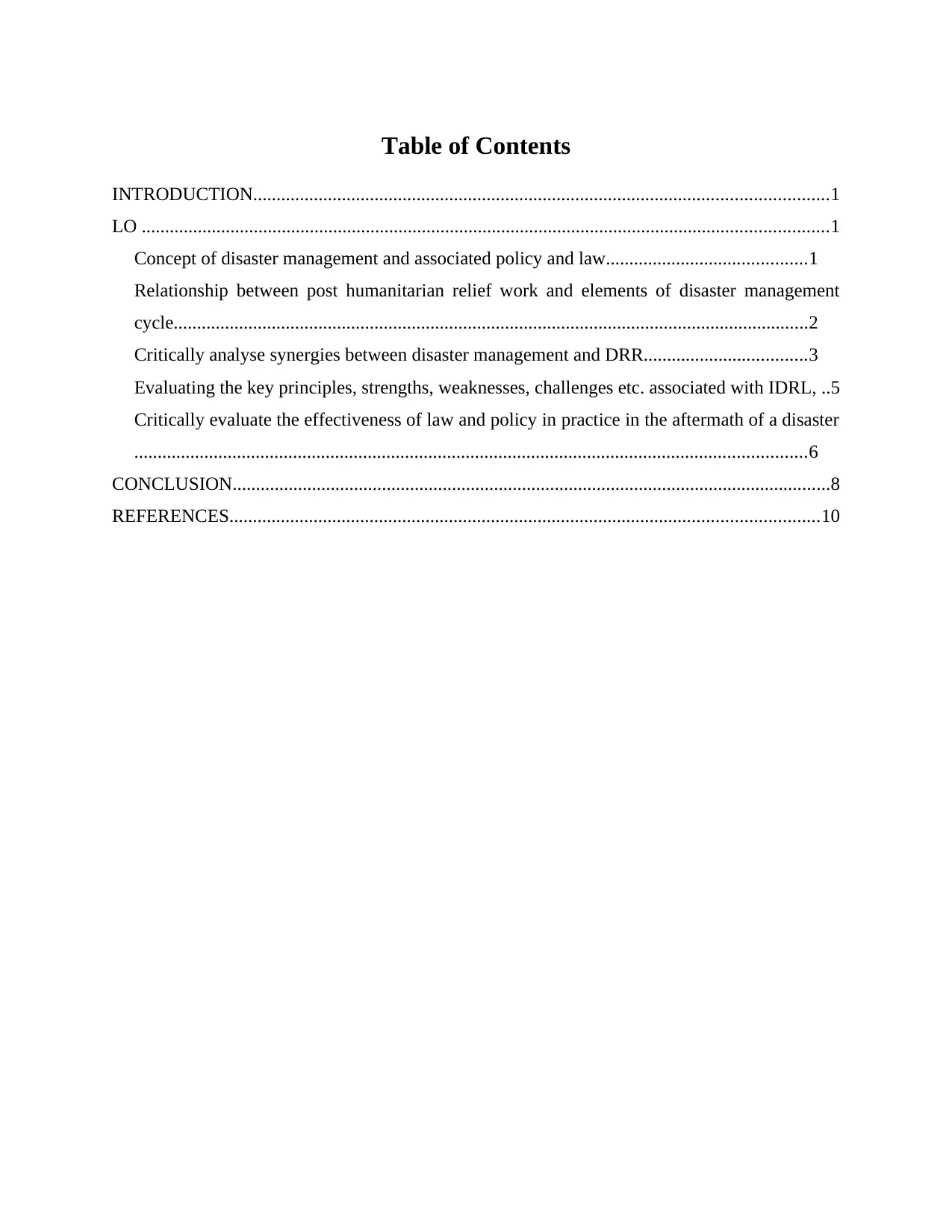
Table of Contents
INTRODUCTION...........................................................................................................................1
LO ...................................................................................................................................................1
Concept of disaster management and associated policy and law...........................................1
Relationship between post humanitarian relief work and elements of disaster management
cycle........................................................................................................................................2
Critically analyse synergies between disaster management and DRR...................................3
Evaluating the key principles, strengths, weaknesses, challenges etc. associated with IDRL, ..5
Critically evaluate the effectiveness of law and policy in practice in the aftermath of a disaster
................................................................................................................................................6
CONCLUSION................................................................................................................................8
REFERENCES..............................................................................................................................10
INTRODUCTION...........................................................................................................................1
LO ...................................................................................................................................................1
Concept of disaster management and associated policy and law...........................................1
Relationship between post humanitarian relief work and elements of disaster management
cycle........................................................................................................................................2
Critically analyse synergies between disaster management and DRR...................................3
Evaluating the key principles, strengths, weaknesses, challenges etc. associated with IDRL, ..5
Critically evaluate the effectiveness of law and policy in practice in the aftermath of a disaster
................................................................................................................................................6
CONCLUSION................................................................................................................................8
REFERENCES..............................................................................................................................10
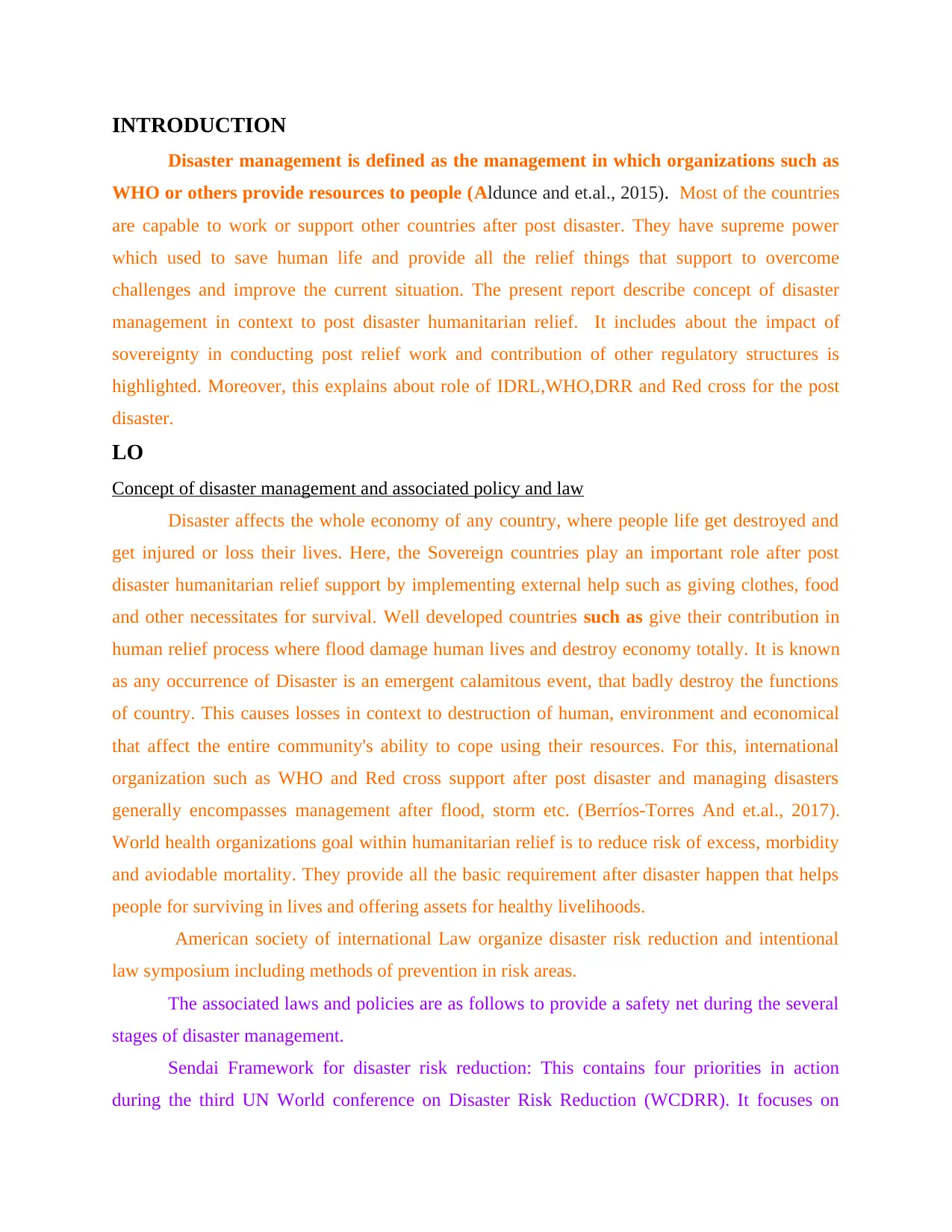
INTRODUCTION
Disaster management is defined as the management in which organizations such as
WHO or others provide resources to people (Aldunce and et.al., 2015). Most of the countries
are capable to work or support other countries after post disaster. They have supreme power
which used to save human life and provide all the relief things that support to overcome
challenges and improve the current situation. The present report describe concept of disaster
management in context to post disaster humanitarian relief. It includes about the impact of
sovereignty in conducting post relief work and contribution of other regulatory structures is
highlighted. Moreover, this explains about role of IDRL,WHO,DRR and Red cross for the post
disaster.
LO
Concept of disaster management and associated policy and law
Disaster affects the whole economy of any country, where people life get destroyed and
get injured or loss their lives. Here, the Sovereign countries play an important role after post
disaster humanitarian relief support by implementing external help such as giving clothes, food
and other necessitates for survival. Well developed countries such as give their contribution in
human relief process where flood damage human lives and destroy economy totally. It is known
as any occurrence of Disaster is an emergent calamitous event, that badly destroy the functions
of country. This causes losses in context to destruction of human, environment and economical
that affect the entire community's ability to cope using their resources. For this, international
organization such as WHO and Red cross support after post disaster and managing disasters
generally encompasses management after flood, storm etc. (Berríos-Torres And et.al., 2017).
World health organizations goal within humanitarian relief is to reduce risk of excess, morbidity
and aviodable mortality. They provide all the basic requirement after disaster happen that helps
people for surviving in lives and offering assets for healthy livelihoods.
American society of international Law organize disaster risk reduction and intentional
law symposium including methods of prevention in risk areas.
The associated laws and policies are as follows to provide a safety net during the several
stages of disaster management.
Sendai Framework for disaster risk reduction: This contains four priorities in action
during the third UN World conference on Disaster Risk Reduction (WCDRR). It focuses on
Disaster management is defined as the management in which organizations such as
WHO or others provide resources to people (Aldunce and et.al., 2015). Most of the countries
are capable to work or support other countries after post disaster. They have supreme power
which used to save human life and provide all the relief things that support to overcome
challenges and improve the current situation. The present report describe concept of disaster
management in context to post disaster humanitarian relief. It includes about the impact of
sovereignty in conducting post relief work and contribution of other regulatory structures is
highlighted. Moreover, this explains about role of IDRL,WHO,DRR and Red cross for the post
disaster.
LO
Concept of disaster management and associated policy and law
Disaster affects the whole economy of any country, where people life get destroyed and
get injured or loss their lives. Here, the Sovereign countries play an important role after post
disaster humanitarian relief support by implementing external help such as giving clothes, food
and other necessitates for survival. Well developed countries such as give their contribution in
human relief process where flood damage human lives and destroy economy totally. It is known
as any occurrence of Disaster is an emergent calamitous event, that badly destroy the functions
of country. This causes losses in context to destruction of human, environment and economical
that affect the entire community's ability to cope using their resources. For this, international
organization such as WHO and Red cross support after post disaster and managing disasters
generally encompasses management after flood, storm etc. (Berríos-Torres And et.al., 2017).
World health organizations goal within humanitarian relief is to reduce risk of excess, morbidity
and aviodable mortality. They provide all the basic requirement after disaster happen that helps
people for surviving in lives and offering assets for healthy livelihoods.
American society of international Law organize disaster risk reduction and intentional
law symposium including methods of prevention in risk areas.
The associated laws and policies are as follows to provide a safety net during the several
stages of disaster management.
Sendai Framework for disaster risk reduction: This contains four priorities in action
during the third UN World conference on Disaster Risk Reduction (WCDRR). It focuses on
⊘ This is a preview!⊘
Do you want full access?
Subscribe today to unlock all pages.

Trusted by 1+ million students worldwide
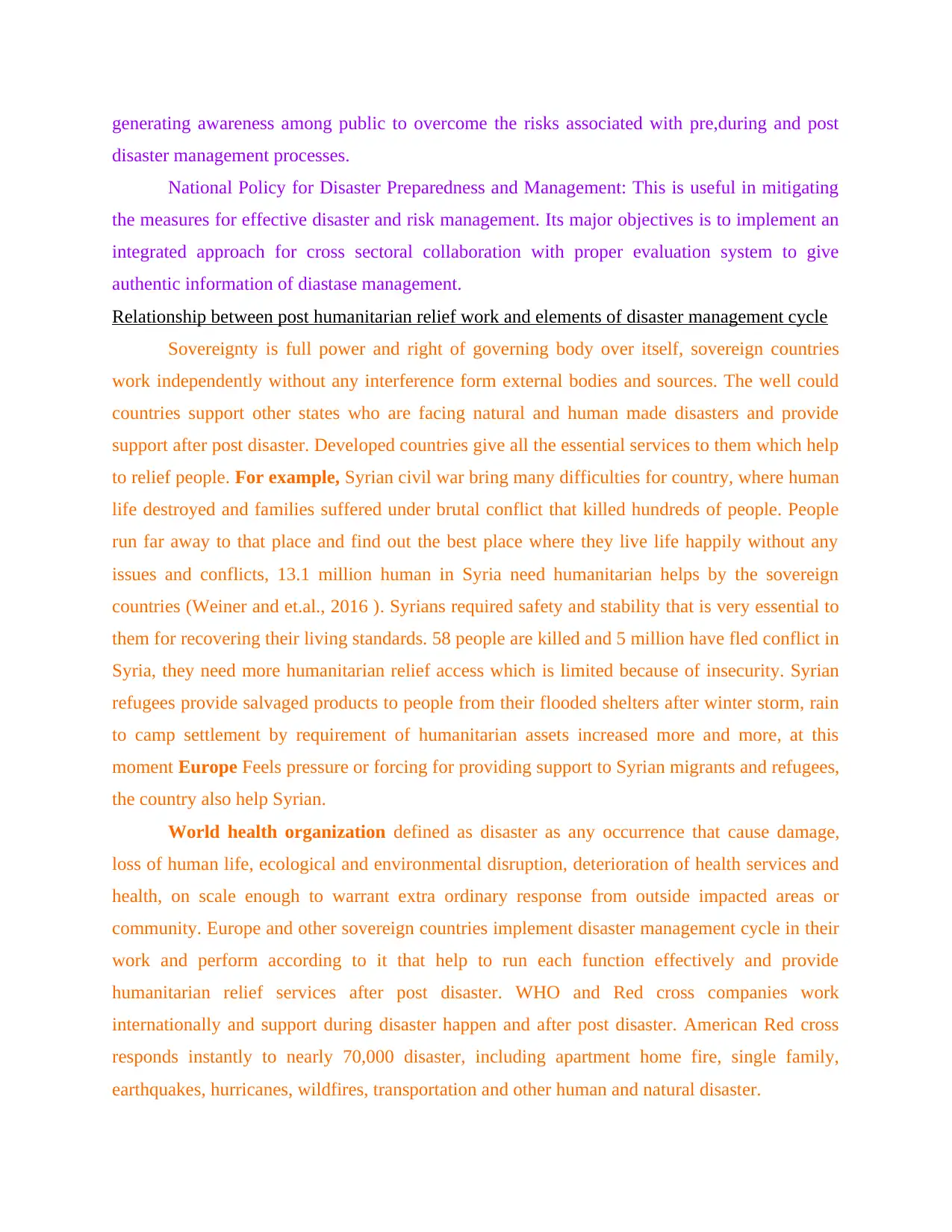
generating awareness among public to overcome the risks associated with pre,during and post
disaster management processes.
National Policy for Disaster Preparedness and Management: This is useful in mitigating
the measures for effective disaster and risk management. Its major objectives is to implement an
integrated approach for cross sectoral collaboration with proper evaluation system to give
authentic information of diastase management.
Relationship between post humanitarian relief work and elements of disaster management cycle
Sovereignty is full power and right of governing body over itself, sovereign countries
work independently without any interference form external bodies and sources. The well could
countries support other states who are facing natural and human made disasters and provide
support after post disaster. Developed countries give all the essential services to them which help
to relief people. For example, Syrian civil war bring many difficulties for country, where human
life destroyed and families suffered under brutal conflict that killed hundreds of people. People
run far away to that place and find out the best place where they live life happily without any
issues and conflicts, 13.1 million human in Syria need humanitarian helps by the sovereign
countries (Weiner and et.al., 2016 ). Syrians required safety and stability that is very essential to
them for recovering their living standards. 58 people are killed and 5 million have fled conflict in
Syria, they need more humanitarian relief access which is limited because of insecurity. Syrian
refugees provide salvaged products to people from their flooded shelters after winter storm, rain
to camp settlement by requirement of humanitarian assets increased more and more, at this
moment Europe Feels pressure or forcing for providing support to Syrian migrants and refugees,
the country also help Syrian.
World health organization defined as disaster as any occurrence that cause damage,
loss of human life, ecological and environmental disruption, deterioration of health services and
health, on scale enough to warrant extra ordinary response from outside impacted areas or
community. Europe and other sovereign countries implement disaster management cycle in their
work and perform according to it that help to run each function effectively and provide
humanitarian relief services after post disaster. WHO and Red cross companies work
internationally and support during disaster happen and after post disaster. American Red cross
responds instantly to nearly 70,000 disaster, including apartment home fire, single family,
earthquakes, hurricanes, wildfires, transportation and other human and natural disaster.
disaster management processes.
National Policy for Disaster Preparedness and Management: This is useful in mitigating
the measures for effective disaster and risk management. Its major objectives is to implement an
integrated approach for cross sectoral collaboration with proper evaluation system to give
authentic information of diastase management.
Relationship between post humanitarian relief work and elements of disaster management cycle
Sovereignty is full power and right of governing body over itself, sovereign countries
work independently without any interference form external bodies and sources. The well could
countries support other states who are facing natural and human made disasters and provide
support after post disaster. Developed countries give all the essential services to them which help
to relief people. For example, Syrian civil war bring many difficulties for country, where human
life destroyed and families suffered under brutal conflict that killed hundreds of people. People
run far away to that place and find out the best place where they live life happily without any
issues and conflicts, 13.1 million human in Syria need humanitarian helps by the sovereign
countries (Weiner and et.al., 2016 ). Syrians required safety and stability that is very essential to
them for recovering their living standards. 58 people are killed and 5 million have fled conflict in
Syria, they need more humanitarian relief access which is limited because of insecurity. Syrian
refugees provide salvaged products to people from their flooded shelters after winter storm, rain
to camp settlement by requirement of humanitarian assets increased more and more, at this
moment Europe Feels pressure or forcing for providing support to Syrian migrants and refugees,
the country also help Syrian.
World health organization defined as disaster as any occurrence that cause damage,
loss of human life, ecological and environmental disruption, deterioration of health services and
health, on scale enough to warrant extra ordinary response from outside impacted areas or
community. Europe and other sovereign countries implement disaster management cycle in their
work and perform according to it that help to run each function effectively and provide
humanitarian relief services after post disaster. WHO and Red cross companies work
internationally and support during disaster happen and after post disaster. American Red cross
responds instantly to nearly 70,000 disaster, including apartment home fire, single family,
earthquakes, hurricanes, wildfires, transportation and other human and natural disaster.
Paraphrase This Document
Need a fresh take? Get an instant paraphrase of this document with our AI Paraphraser
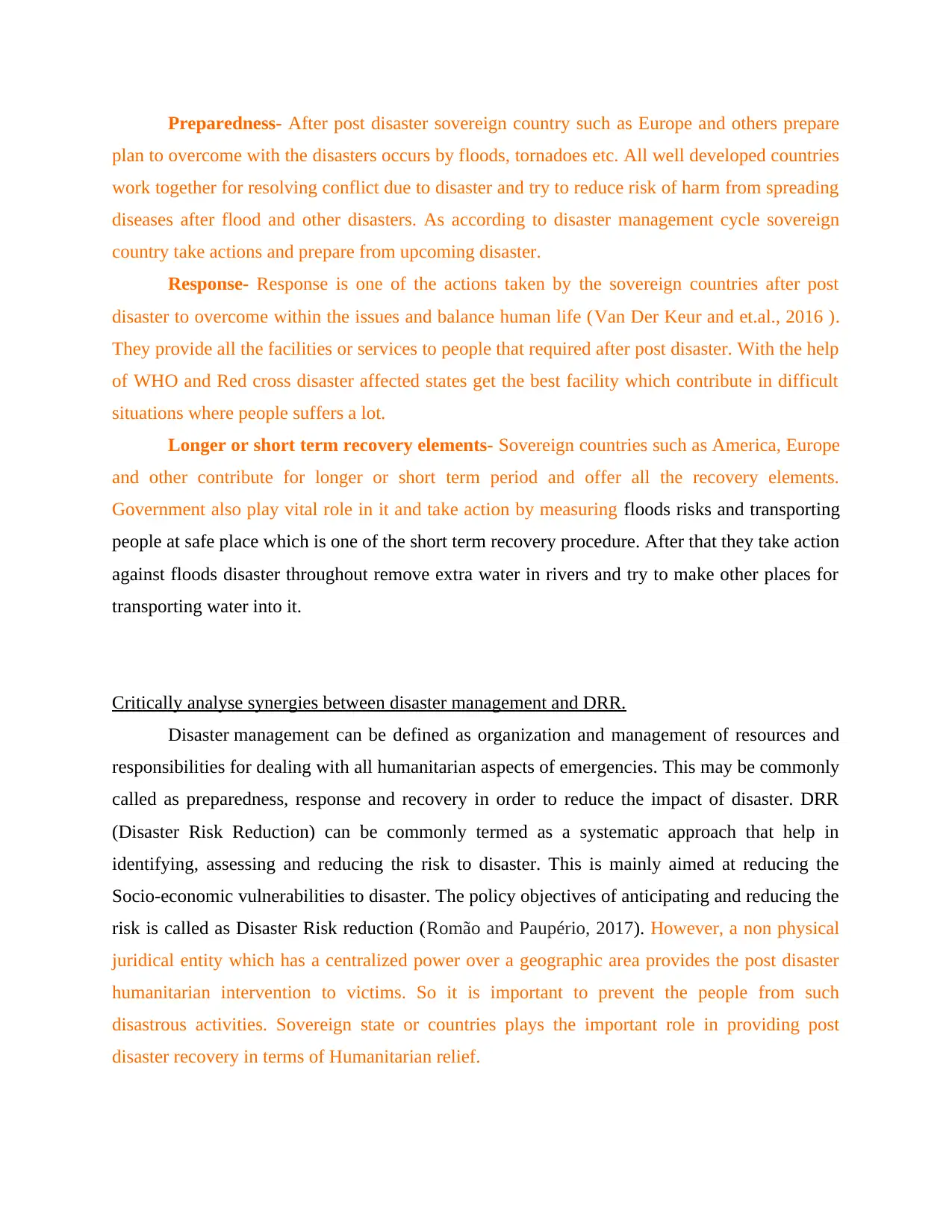
Preparedness- After post disaster sovereign country such as Europe and others prepare
plan to overcome with the disasters occurs by floods, tornadoes etc. All well developed countries
work together for resolving conflict due to disaster and try to reduce risk of harm from spreading
diseases after flood and other disasters. As according to disaster management cycle sovereign
country take actions and prepare from upcoming disaster.
Response- Response is one of the actions taken by the sovereign countries after post
disaster to overcome within the issues and balance human life (Van Der Keur and et.al., 2016 ).
They provide all the facilities or services to people that required after post disaster. With the help
of WHO and Red cross disaster affected states get the best facility which contribute in difficult
situations where people suffers a lot.
Longer or short term recovery elements- Sovereign countries such as America, Europe
and other contribute for longer or short term period and offer all the recovery elements.
Government also play vital role in it and take action by measuring floods risks and transporting
people at safe place which is one of the short term recovery procedure. After that they take action
against floods disaster throughout remove extra water in rivers and try to make other places for
transporting water into it.
Critically analyse synergies between disaster management and DRR.
Disaster management can be defined as organization and management of resources and
responsibilities for dealing with all humanitarian aspects of emergencies. This may be commonly
called as preparedness, response and recovery in order to reduce the impact of disaster. DRR
(Disaster Risk Reduction) can be commonly termed as a systematic approach that help in
identifying, assessing and reducing the risk to disaster. This is mainly aimed at reducing the
Socio-economic vulnerabilities to disaster. The policy objectives of anticipating and reducing the
risk is called as Disaster Risk reduction (Romão and Paupério, 2017). However, a non physical
juridical entity which has a centralized power over a geographic area provides the post disaster
humanitarian intervention to victims. So it is important to prevent the people from such
disastrous activities. Sovereign state or countries plays the important role in providing post
disaster recovery in terms of Humanitarian relief.
plan to overcome with the disasters occurs by floods, tornadoes etc. All well developed countries
work together for resolving conflict due to disaster and try to reduce risk of harm from spreading
diseases after flood and other disasters. As according to disaster management cycle sovereign
country take actions and prepare from upcoming disaster.
Response- Response is one of the actions taken by the sovereign countries after post
disaster to overcome within the issues and balance human life (Van Der Keur and et.al., 2016 ).
They provide all the facilities or services to people that required after post disaster. With the help
of WHO and Red cross disaster affected states get the best facility which contribute in difficult
situations where people suffers a lot.
Longer or short term recovery elements- Sovereign countries such as America, Europe
and other contribute for longer or short term period and offer all the recovery elements.
Government also play vital role in it and take action by measuring floods risks and transporting
people at safe place which is one of the short term recovery procedure. After that they take action
against floods disaster throughout remove extra water in rivers and try to make other places for
transporting water into it.
Critically analyse synergies between disaster management and DRR.
Disaster management can be defined as organization and management of resources and
responsibilities for dealing with all humanitarian aspects of emergencies. This may be commonly
called as preparedness, response and recovery in order to reduce the impact of disaster. DRR
(Disaster Risk Reduction) can be commonly termed as a systematic approach that help in
identifying, assessing and reducing the risk to disaster. This is mainly aimed at reducing the
Socio-economic vulnerabilities to disaster. The policy objectives of anticipating and reducing the
risk is called as Disaster Risk reduction (Romão and Paupério, 2017). However, a non physical
juridical entity which has a centralized power over a geographic area provides the post disaster
humanitarian intervention to victims. So it is important to prevent the people from such
disastrous activities. Sovereign state or countries plays the important role in providing post
disaster recovery in terms of Humanitarian relief.
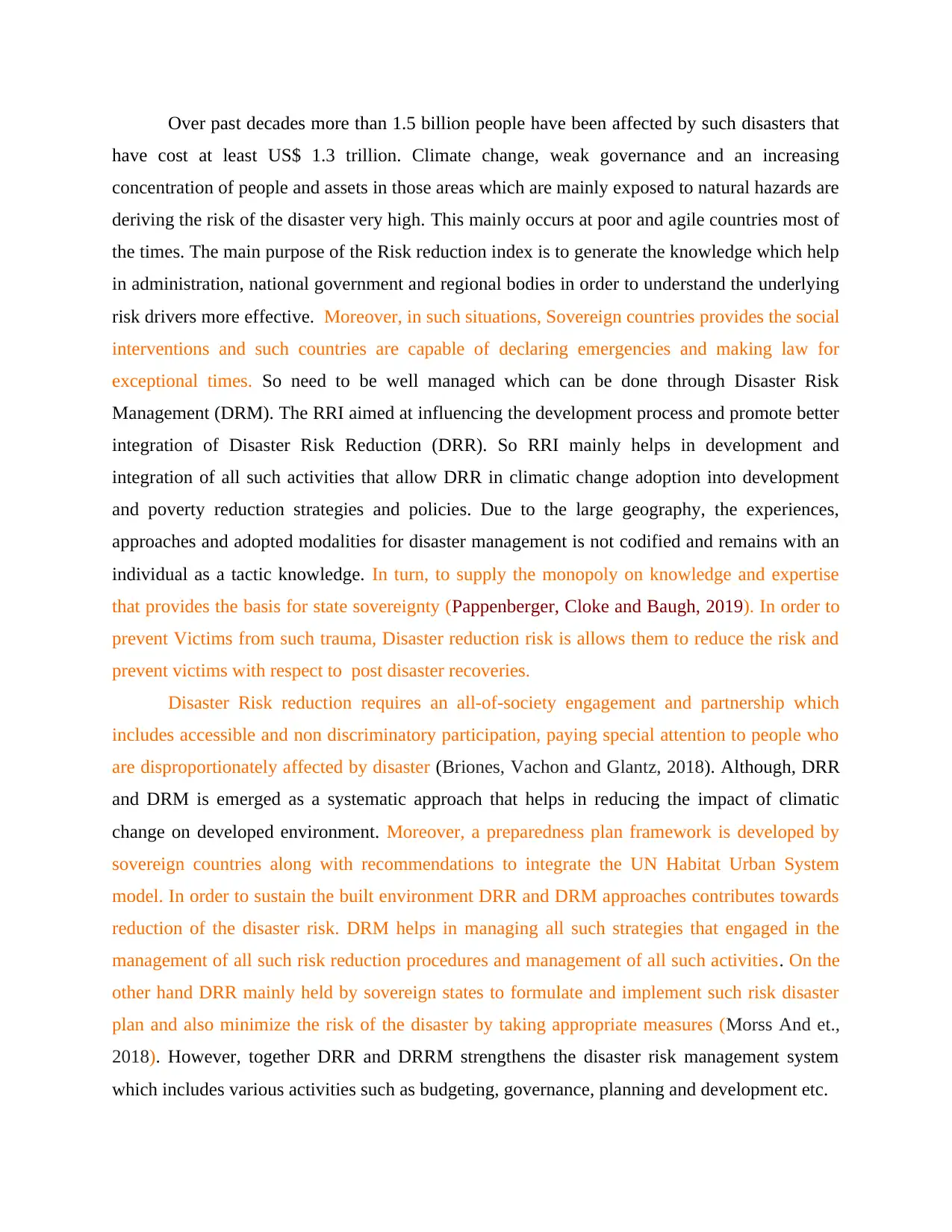
Over past decades more than 1.5 billion people have been affected by such disasters that
have cost at least US$ 1.3 trillion. Climate change, weak governance and an increasing
concentration of people and assets in those areas which are mainly exposed to natural hazards are
deriving the risk of the disaster very high. This mainly occurs at poor and agile countries most of
the times. The main purpose of the Risk reduction index is to generate the knowledge which help
in administration, national government and regional bodies in order to understand the underlying
risk drivers more effective. Moreover, in such situations, Sovereign countries provides the social
interventions and such countries are capable of declaring emergencies and making law for
exceptional times. So need to be well managed which can be done through Disaster Risk
Management (DRM). The RRI aimed at influencing the development process and promote better
integration of Disaster Risk Reduction (DRR). So RRI mainly helps in development and
integration of all such activities that allow DRR in climatic change adoption into development
and poverty reduction strategies and policies. Due to the large geography, the experiences,
approaches and adopted modalities for disaster management is not codified and remains with an
individual as a tactic knowledge. In turn, to supply the monopoly on knowledge and expertise
that provides the basis for state sovereignty (Pappenberger, Cloke and Baugh, 2019). In order to
prevent Victims from such trauma, Disaster reduction risk is allows them to reduce the risk and
prevent victims with respect to post disaster recoveries.
Disaster Risk reduction requires an all-of-society engagement and partnership which
includes accessible and non discriminatory participation, paying special attention to people who
are disproportionately affected by disaster (Briones, Vachon and Glantz, 2018). Although, DRR
and DRM is emerged as a systematic approach that helps in reducing the impact of climatic
change on developed environment. Moreover, a preparedness plan framework is developed by
sovereign countries along with recommendations to integrate the UN Habitat Urban System
model. In order to sustain the built environment DRR and DRM approaches contributes towards
reduction of the disaster risk. DRM helps in managing all such strategies that engaged in the
management of all such risk reduction procedures and management of all such activities. On the
other hand DRR mainly held by sovereign states to formulate and implement such risk disaster
plan and also minimize the risk of the disaster by taking appropriate measures (Morss And et.,
2018). However, together DRR and DRRM strengthens the disaster risk management system
which includes various activities such as budgeting, governance, planning and development etc.
have cost at least US$ 1.3 trillion. Climate change, weak governance and an increasing
concentration of people and assets in those areas which are mainly exposed to natural hazards are
deriving the risk of the disaster very high. This mainly occurs at poor and agile countries most of
the times. The main purpose of the Risk reduction index is to generate the knowledge which help
in administration, national government and regional bodies in order to understand the underlying
risk drivers more effective. Moreover, in such situations, Sovereign countries provides the social
interventions and such countries are capable of declaring emergencies and making law for
exceptional times. So need to be well managed which can be done through Disaster Risk
Management (DRM). The RRI aimed at influencing the development process and promote better
integration of Disaster Risk Reduction (DRR). So RRI mainly helps in development and
integration of all such activities that allow DRR in climatic change adoption into development
and poverty reduction strategies and policies. Due to the large geography, the experiences,
approaches and adopted modalities for disaster management is not codified and remains with an
individual as a tactic knowledge. In turn, to supply the monopoly on knowledge and expertise
that provides the basis for state sovereignty (Pappenberger, Cloke and Baugh, 2019). In order to
prevent Victims from such trauma, Disaster reduction risk is allows them to reduce the risk and
prevent victims with respect to post disaster recoveries.
Disaster Risk reduction requires an all-of-society engagement and partnership which
includes accessible and non discriminatory participation, paying special attention to people who
are disproportionately affected by disaster (Briones, Vachon and Glantz, 2018). Although, DRR
and DRM is emerged as a systematic approach that helps in reducing the impact of climatic
change on developed environment. Moreover, a preparedness plan framework is developed by
sovereign countries along with recommendations to integrate the UN Habitat Urban System
model. In order to sustain the built environment DRR and DRM approaches contributes towards
reduction of the disaster risk. DRM helps in managing all such strategies that engaged in the
management of all such risk reduction procedures and management of all such activities. On the
other hand DRR mainly held by sovereign states to formulate and implement such risk disaster
plan and also minimize the risk of the disaster by taking appropriate measures (Morss And et.,
2018). However, together DRR and DRRM strengthens the disaster risk management system
which includes various activities such as budgeting, governance, planning and development etc.
⊘ This is a preview!⊘
Do you want full access?
Subscribe today to unlock all pages.

Trusted by 1+ million students worldwide
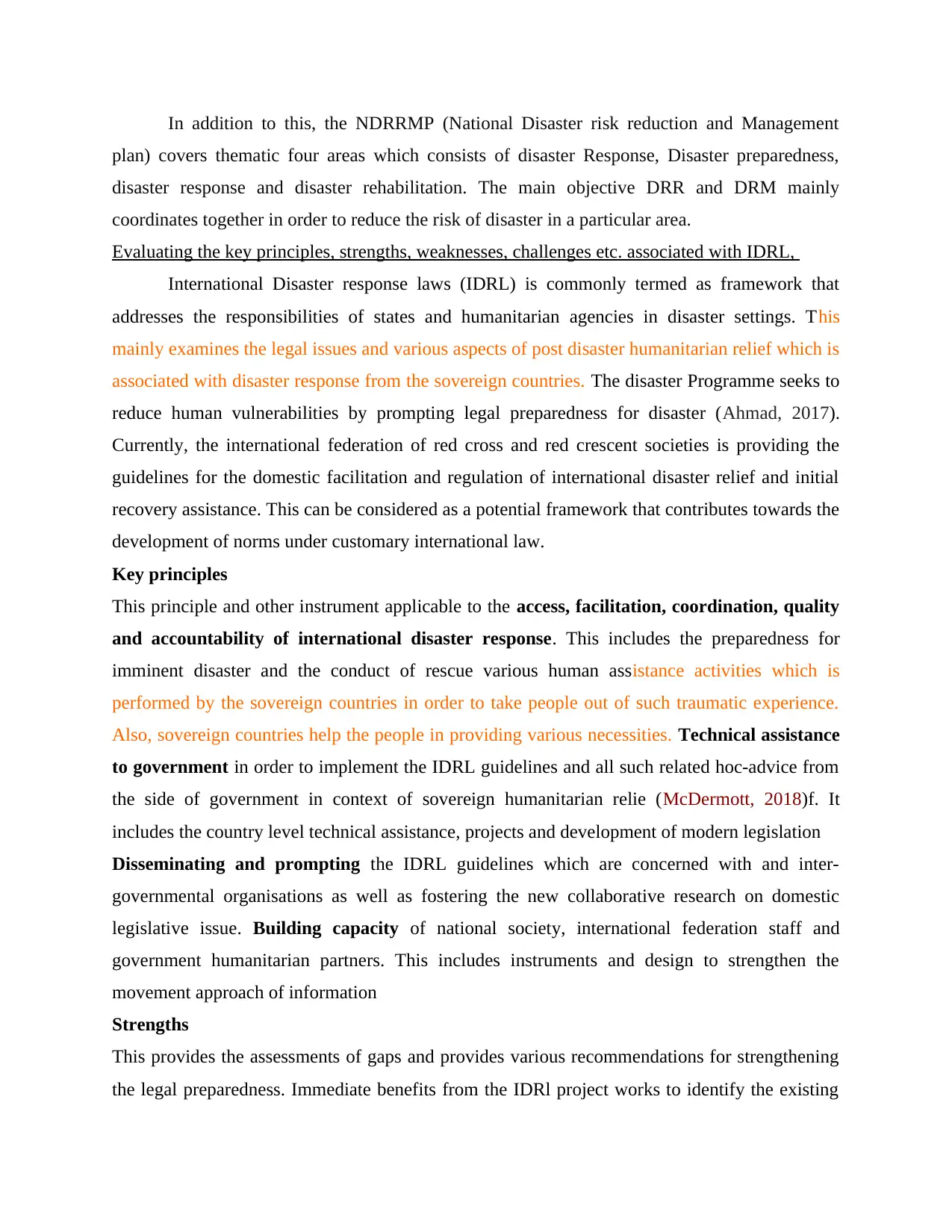
In addition to this, the NDRRMP (National Disaster risk reduction and Management
plan) covers thematic four areas which consists of disaster Response, Disaster preparedness,
disaster response and disaster rehabilitation. The main objective DRR and DRM mainly
coordinates together in order to reduce the risk of disaster in a particular area.
Evaluating the key principles, strengths, weaknesses, challenges etc. associated with IDRL,
International Disaster response laws (IDRL) is commonly termed as framework that
addresses the responsibilities of states and humanitarian agencies in disaster settings. This
mainly examines the legal issues and various aspects of post disaster humanitarian relief which is
associated with disaster response from the sovereign countries. The disaster Programme seeks to
reduce human vulnerabilities by prompting legal preparedness for disaster (Ahmad, 2017).
Currently, the international federation of red cross and red crescent societies is providing the
guidelines for the domestic facilitation and regulation of international disaster relief and initial
recovery assistance. This can be considered as a potential framework that contributes towards the
development of norms under customary international law.
Key principles
This principle and other instrument applicable to the access, facilitation, coordination, quality
and accountability of international disaster response. This includes the preparedness for
imminent disaster and the conduct of rescue various human assistance activities which is
performed by the sovereign countries in order to take people out of such traumatic experience.
Also, sovereign countries help the people in providing various necessities. Technical assistance
to government in order to implement the IDRL guidelines and all such related hoc-advice from
the side of government in context of sovereign humanitarian relie (McDermott, 2018)f. It
includes the country level technical assistance, projects and development of modern legislation
Disseminating and prompting the IDRL guidelines which are concerned with and inter-
governmental organisations as well as fostering the new collaborative research on domestic
legislative issue. Building capacity of national society, international federation staff and
government humanitarian partners. This includes instruments and design to strengthen the
movement approach of information
Strengths
This provides the assessments of gaps and provides various recommendations for strengthening
the legal preparedness. Immediate benefits from the IDRl project works to identify the existing
plan) covers thematic four areas which consists of disaster Response, Disaster preparedness,
disaster response and disaster rehabilitation. The main objective DRR and DRM mainly
coordinates together in order to reduce the risk of disaster in a particular area.
Evaluating the key principles, strengths, weaknesses, challenges etc. associated with IDRL,
International Disaster response laws (IDRL) is commonly termed as framework that
addresses the responsibilities of states and humanitarian agencies in disaster settings. This
mainly examines the legal issues and various aspects of post disaster humanitarian relief which is
associated with disaster response from the sovereign countries. The disaster Programme seeks to
reduce human vulnerabilities by prompting legal preparedness for disaster (Ahmad, 2017).
Currently, the international federation of red cross and red crescent societies is providing the
guidelines for the domestic facilitation and regulation of international disaster relief and initial
recovery assistance. This can be considered as a potential framework that contributes towards the
development of norms under customary international law.
Key principles
This principle and other instrument applicable to the access, facilitation, coordination, quality
and accountability of international disaster response. This includes the preparedness for
imminent disaster and the conduct of rescue various human assistance activities which is
performed by the sovereign countries in order to take people out of such traumatic experience.
Also, sovereign countries help the people in providing various necessities. Technical assistance
to government in order to implement the IDRL guidelines and all such related hoc-advice from
the side of government in context of sovereign humanitarian relie (McDermott, 2018)f. It
includes the country level technical assistance, projects and development of modern legislation
Disseminating and prompting the IDRL guidelines which are concerned with and inter-
governmental organisations as well as fostering the new collaborative research on domestic
legislative issue. Building capacity of national society, international federation staff and
government humanitarian partners. This includes instruments and design to strengthen the
movement approach of information
Strengths
This provides the assessments of gaps and provides various recommendations for strengthening
the legal preparedness. Immediate benefits from the IDRl project works to identify the existing
Paraphrase This Document
Need a fresh take? Get an instant paraphrase of this document with our AI Paraphraser
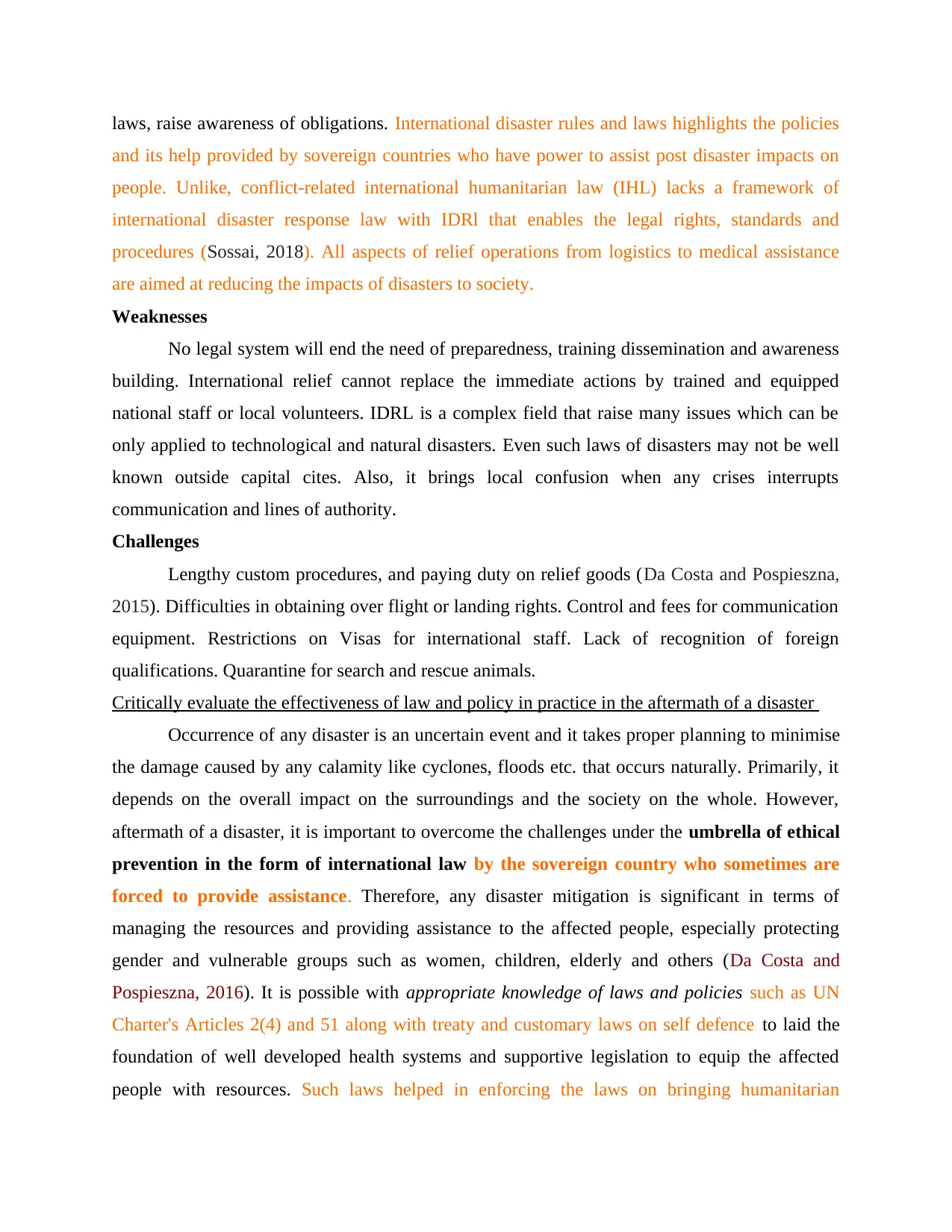
laws, raise awareness of obligations. International disaster rules and laws highlights the policies
and its help provided by sovereign countries who have power to assist post disaster impacts on
people. Unlike, conflict-related international humanitarian law (IHL) lacks a framework of
international disaster response law with IDRl that enables the legal rights, standards and
procedures (Sossai, 2018). All aspects of relief operations from logistics to medical assistance
are aimed at reducing the impacts of disasters to society.
Weaknesses
No legal system will end the need of preparedness, training dissemination and awareness
building. International relief cannot replace the immediate actions by trained and equipped
national staff or local volunteers. IDRL is a complex field that raise many issues which can be
only applied to technological and natural disasters. Even such laws of disasters may not be well
known outside capital cites. Also, it brings local confusion when any crises interrupts
communication and lines of authority.
Challenges
Lengthy custom procedures, and paying duty on relief goods (Da Costa and Pospieszna,
2015). Difficulties in obtaining over flight or landing rights. Control and fees for communication
equipment. Restrictions on Visas for international staff. Lack of recognition of foreign
qualifications. Quarantine for search and rescue animals.
Critically evaluate the effectiveness of law and policy in practice in the aftermath of a disaster
Occurrence of any disaster is an uncertain event and it takes proper planning to minimise
the damage caused by any calamity like cyclones, floods etc. that occurs naturally. Primarily, it
depends on the overall impact on the surroundings and the society on the whole. However,
aftermath of a disaster, it is important to overcome the challenges under the umbrella of ethical
prevention in the form of international law by the sovereign country who sometimes are
forced to provide assistance. Therefore, any disaster mitigation is significant in terms of
managing the resources and providing assistance to the affected people, especially protecting
gender and vulnerable groups such as women, children, elderly and others (Da Costa and
Pospieszna, 2016). It is possible with appropriate knowledge of laws and policies such as UN
Charter's Articles 2(4) and 51 along with treaty and customary laws on self defence to laid the
foundation of well developed health systems and supportive legislation to equip the affected
people with resources. Such laws helped in enforcing the laws on bringing humanitarian
and its help provided by sovereign countries who have power to assist post disaster impacts on
people. Unlike, conflict-related international humanitarian law (IHL) lacks a framework of
international disaster response law with IDRl that enables the legal rights, standards and
procedures (Sossai, 2018). All aspects of relief operations from logistics to medical assistance
are aimed at reducing the impacts of disasters to society.
Weaknesses
No legal system will end the need of preparedness, training dissemination and awareness
building. International relief cannot replace the immediate actions by trained and equipped
national staff or local volunteers. IDRL is a complex field that raise many issues which can be
only applied to technological and natural disasters. Even such laws of disasters may not be well
known outside capital cites. Also, it brings local confusion when any crises interrupts
communication and lines of authority.
Challenges
Lengthy custom procedures, and paying duty on relief goods (Da Costa and Pospieszna,
2015). Difficulties in obtaining over flight or landing rights. Control and fees for communication
equipment. Restrictions on Visas for international staff. Lack of recognition of foreign
qualifications. Quarantine for search and rescue animals.
Critically evaluate the effectiveness of law and policy in practice in the aftermath of a disaster
Occurrence of any disaster is an uncertain event and it takes proper planning to minimise
the damage caused by any calamity like cyclones, floods etc. that occurs naturally. Primarily, it
depends on the overall impact on the surroundings and the society on the whole. However,
aftermath of a disaster, it is important to overcome the challenges under the umbrella of ethical
prevention in the form of international law by the sovereign country who sometimes are
forced to provide assistance. Therefore, any disaster mitigation is significant in terms of
managing the resources and providing assistance to the affected people, especially protecting
gender and vulnerable groups such as women, children, elderly and others (Da Costa and
Pospieszna, 2016). It is possible with appropriate knowledge of laws and policies such as UN
Charter's Articles 2(4) and 51 along with treaty and customary laws on self defence to laid the
foundation of well developed health systems and supportive legislation to equip the affected
people with resources. Such laws helped in enforcing the laws on bringing humanitarian
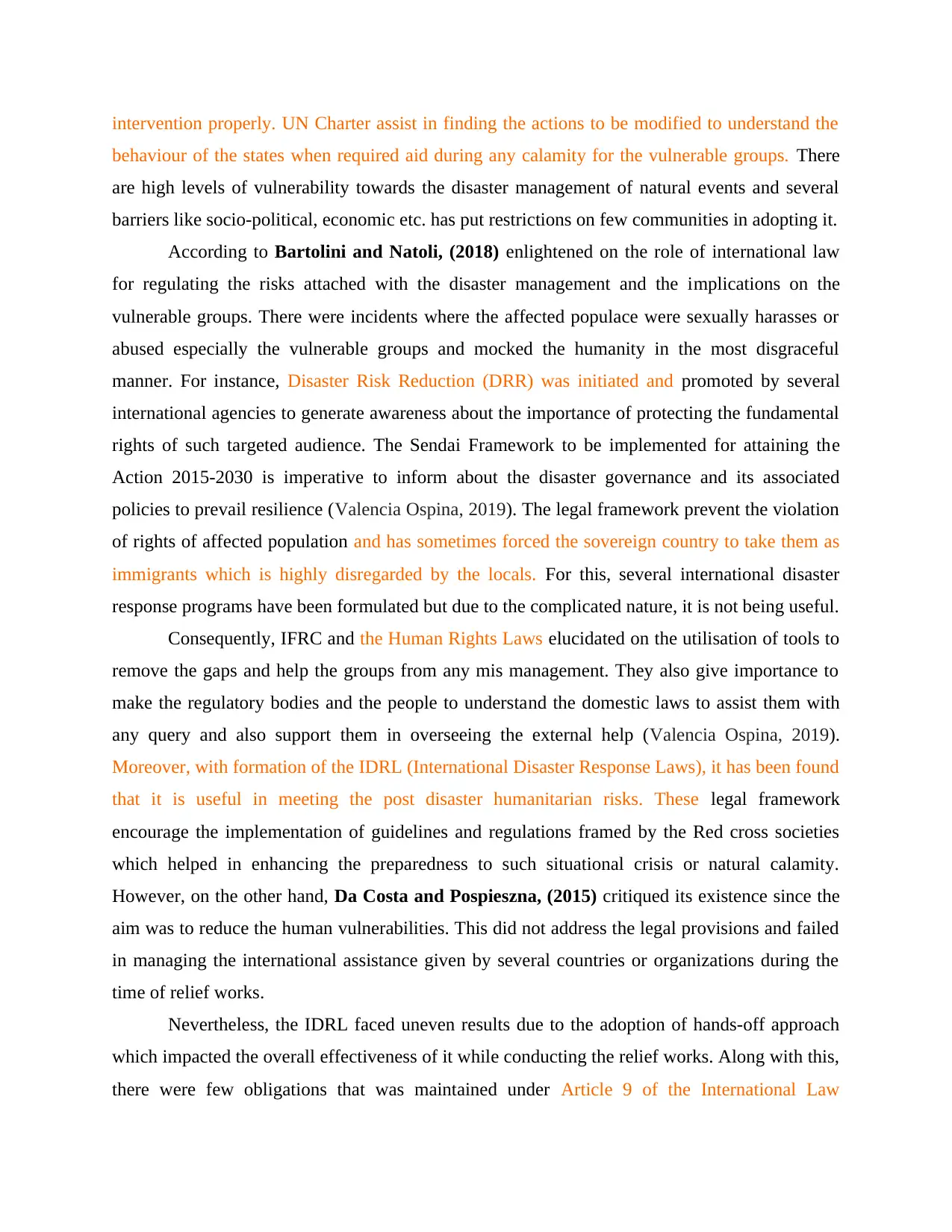
intervention properly. UN Charter assist in finding the actions to be modified to understand the
behaviour of the states when required aid during any calamity for the vulnerable groups. There
are high levels of vulnerability towards the disaster management of natural events and several
barriers like socio-political, economic etc. has put restrictions on few communities in adopting it.
According to Bartolini and Natoli, (2018) enlightened on the role of international law
for regulating the risks attached with the disaster management and the implications on the
vulnerable groups. There were incidents where the affected populace were sexually harasses or
abused especially the vulnerable groups and mocked the humanity in the most disgraceful
manner. For instance, Disaster Risk Reduction (DRR) was initiated and promoted by several
international agencies to generate awareness about the importance of protecting the fundamental
rights of such targeted audience. The Sendai Framework to be implemented for attaining the
Action 2015-2030 is imperative to inform about the disaster governance and its associated
policies to prevail resilience (Valencia Ospina, 2019). The legal framework prevent the violation
of rights of affected population and has sometimes forced the sovereign country to take them as
immigrants which is highly disregarded by the locals. For this, several international disaster
response programs have been formulated but due to the complicated nature, it is not being useful.
Consequently, IFRC and the Human Rights Laws elucidated on the utilisation of tools to
remove the gaps and help the groups from any mis management. They also give importance to
make the regulatory bodies and the people to understand the domestic laws to assist them with
any query and also support them in overseeing the external help (Valencia Ospina, 2019).
Moreover, with formation of the IDRL (International Disaster Response Laws), it has been found
that it is useful in meeting the post disaster humanitarian risks. These legal framework
encourage the implementation of guidelines and regulations framed by the Red cross societies
which helped in enhancing the preparedness to such situational crisis or natural calamity.
However, on the other hand, Da Costa and Pospieszna, (2015) critiqued its existence since the
aim was to reduce the human vulnerabilities. This did not address the legal provisions and failed
in managing the international assistance given by several countries or organizations during the
time of relief works.
Nevertheless, the IDRL faced uneven results due to the adoption of hands-off approach
which impacted the overall effectiveness of it while conducting the relief works. Along with this,
there were few obligations that was maintained under Article 9 of the International Law
behaviour of the states when required aid during any calamity for the vulnerable groups. There
are high levels of vulnerability towards the disaster management of natural events and several
barriers like socio-political, economic etc. has put restrictions on few communities in adopting it.
According to Bartolini and Natoli, (2018) enlightened on the role of international law
for regulating the risks attached with the disaster management and the implications on the
vulnerable groups. There were incidents where the affected populace were sexually harasses or
abused especially the vulnerable groups and mocked the humanity in the most disgraceful
manner. For instance, Disaster Risk Reduction (DRR) was initiated and promoted by several
international agencies to generate awareness about the importance of protecting the fundamental
rights of such targeted audience. The Sendai Framework to be implemented for attaining the
Action 2015-2030 is imperative to inform about the disaster governance and its associated
policies to prevail resilience (Valencia Ospina, 2019). The legal framework prevent the violation
of rights of affected population and has sometimes forced the sovereign country to take them as
immigrants which is highly disregarded by the locals. For this, several international disaster
response programs have been formulated but due to the complicated nature, it is not being useful.
Consequently, IFRC and the Human Rights Laws elucidated on the utilisation of tools to
remove the gaps and help the groups from any mis management. They also give importance to
make the regulatory bodies and the people to understand the domestic laws to assist them with
any query and also support them in overseeing the external help (Valencia Ospina, 2019).
Moreover, with formation of the IDRL (International Disaster Response Laws), it has been found
that it is useful in meeting the post disaster humanitarian risks. These legal framework
encourage the implementation of guidelines and regulations framed by the Red cross societies
which helped in enhancing the preparedness to such situational crisis or natural calamity.
However, on the other hand, Da Costa and Pospieszna, (2015) critiqued its existence since the
aim was to reduce the human vulnerabilities. This did not address the legal provisions and failed
in managing the international assistance given by several countries or organizations during the
time of relief works.
Nevertheless, the IDRL faced uneven results due to the adoption of hands-off approach
which impacted the overall effectiveness of it while conducting the relief works. Along with this,
there were few obligations that was maintained under Article 9 of the International Law
⊘ This is a preview!⊘
Do you want full access?
Subscribe today to unlock all pages.

Trusted by 1+ million students worldwide
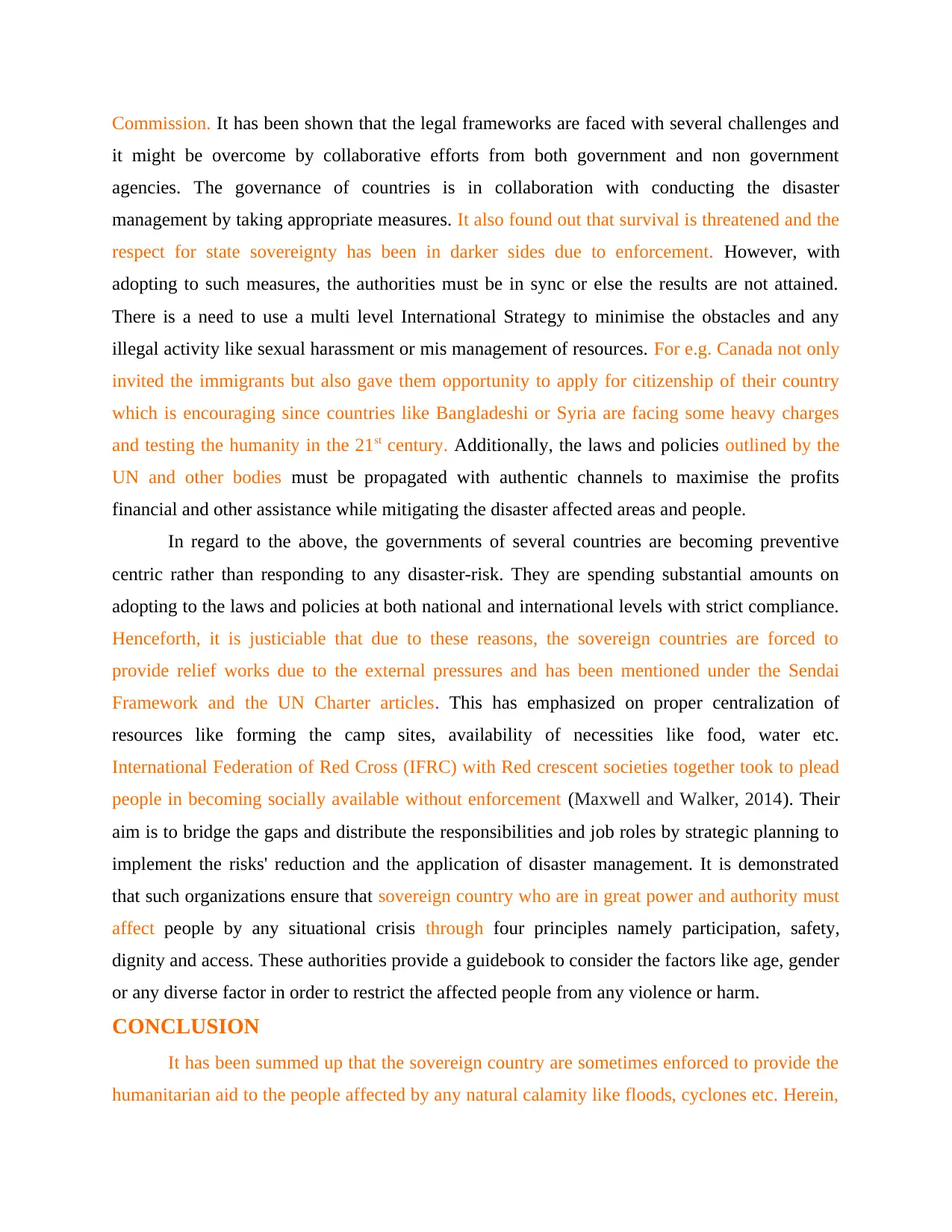
Commission. It has been shown that the legal frameworks are faced with several challenges and
it might be overcome by collaborative efforts from both government and non government
agencies. The governance of countries is in collaboration with conducting the disaster
management by taking appropriate measures. It also found out that survival is threatened and the
respect for state sovereignty has been in darker sides due to enforcement. However, with
adopting to such measures, the authorities must be in sync or else the results are not attained.
There is a need to use a multi level International Strategy to minimise the obstacles and any
illegal activity like sexual harassment or mis management of resources. For e.g. Canada not only
invited the immigrants but also gave them opportunity to apply for citizenship of their country
which is encouraging since countries like Bangladeshi or Syria are facing some heavy charges
and testing the humanity in the 21st century. Additionally, the laws and policies outlined by the
UN and other bodies must be propagated with authentic channels to maximise the profits
financial and other assistance while mitigating the disaster affected areas and people.
In regard to the above, the governments of several countries are becoming preventive
centric rather than responding to any disaster-risk. They are spending substantial amounts on
adopting to the laws and policies at both national and international levels with strict compliance.
Henceforth, it is justiciable that due to these reasons, the sovereign countries are forced to
provide relief works due to the external pressures and has been mentioned under the Sendai
Framework and the UN Charter articles. This has emphasized on proper centralization of
resources like forming the camp sites, availability of necessities like food, water etc.
International Federation of Red Cross (IFRC) with Red crescent societies together took to plead
people in becoming socially available without enforcement (Maxwell and Walker, 2014). Their
aim is to bridge the gaps and distribute the responsibilities and job roles by strategic planning to
implement the risks' reduction and the application of disaster management. It is demonstrated
that such organizations ensure that sovereign country who are in great power and authority must
affect people by any situational crisis through four principles namely participation, safety,
dignity and access. These authorities provide a guidebook to consider the factors like age, gender
or any diverse factor in order to restrict the affected people from any violence or harm.
CONCLUSION
It has been summed up that the sovereign country are sometimes enforced to provide the
humanitarian aid to the people affected by any natural calamity like floods, cyclones etc. Herein,
it might be overcome by collaborative efforts from both government and non government
agencies. The governance of countries is in collaboration with conducting the disaster
management by taking appropriate measures. It also found out that survival is threatened and the
respect for state sovereignty has been in darker sides due to enforcement. However, with
adopting to such measures, the authorities must be in sync or else the results are not attained.
There is a need to use a multi level International Strategy to minimise the obstacles and any
illegal activity like sexual harassment or mis management of resources. For e.g. Canada not only
invited the immigrants but also gave them opportunity to apply for citizenship of their country
which is encouraging since countries like Bangladeshi or Syria are facing some heavy charges
and testing the humanity in the 21st century. Additionally, the laws and policies outlined by the
UN and other bodies must be propagated with authentic channels to maximise the profits
financial and other assistance while mitigating the disaster affected areas and people.
In regard to the above, the governments of several countries are becoming preventive
centric rather than responding to any disaster-risk. They are spending substantial amounts on
adopting to the laws and policies at both national and international levels with strict compliance.
Henceforth, it is justiciable that due to these reasons, the sovereign countries are forced to
provide relief works due to the external pressures and has been mentioned under the Sendai
Framework and the UN Charter articles. This has emphasized on proper centralization of
resources like forming the camp sites, availability of necessities like food, water etc.
International Federation of Red Cross (IFRC) with Red crescent societies together took to plead
people in becoming socially available without enforcement (Maxwell and Walker, 2014). Their
aim is to bridge the gaps and distribute the responsibilities and job roles by strategic planning to
implement the risks' reduction and the application of disaster management. It is demonstrated
that such organizations ensure that sovereign country who are in great power and authority must
affect people by any situational crisis through four principles namely participation, safety,
dignity and access. These authorities provide a guidebook to consider the factors like age, gender
or any diverse factor in order to restrict the affected people from any violence or harm.
CONCLUSION
It has been summed up that the sovereign country are sometimes enforced to provide the
humanitarian aid to the people affected by any natural calamity like floods, cyclones etc. Herein,
Paraphrase This Document
Need a fresh take? Get an instant paraphrase of this document with our AI Paraphraser

the effectiveness in using the laws, regulations and policies has been examined for safeguarding
the rights of the vulnerable groups for uplifting the conditions via relief work.
the rights of the vulnerable groups for uplifting the conditions via relief work.
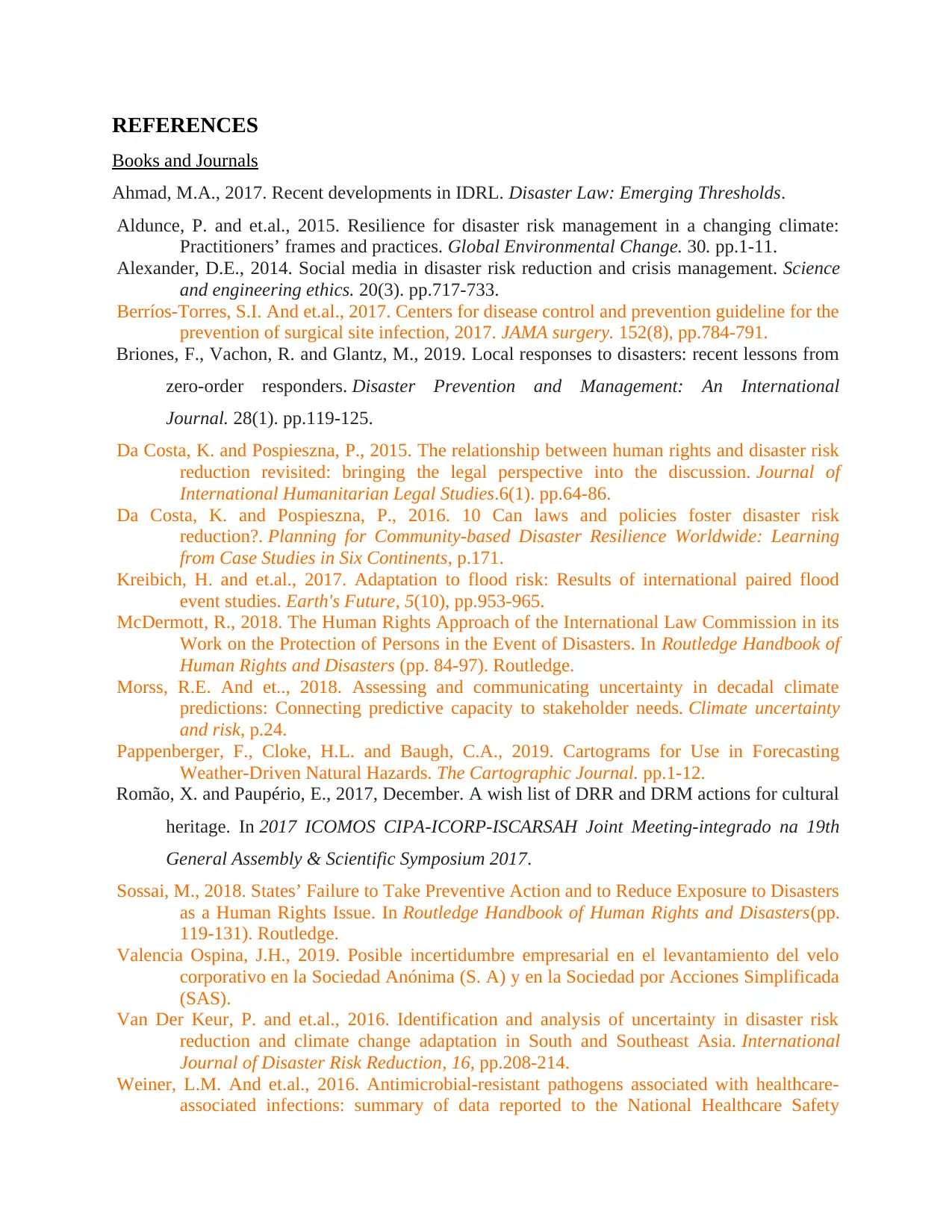
REFERENCES
Books and Journals
Ahmad, M.A., 2017. Recent developments in IDRL. Disaster Law: Emerging Thresholds.
Aldunce, P. and et.al., 2015. Resilience for disaster risk management in a changing climate:
Practitioners’ frames and practices. Global Environmental Change. 30. pp.1-11.
Alexander, D.E., 2014. Social media in disaster risk reduction and crisis management. Science
and engineering ethics. 20(3). pp.717-733.
Berríos-Torres, S.I. And et.al., 2017. Centers for disease control and prevention guideline for the
prevention of surgical site infection, 2017. JAMA surgery. 152(8), pp.784-791.
Briones, F., Vachon, R. and Glantz, M., 2019. Local responses to disasters: recent lessons from
zero-order responders. Disaster Prevention and Management: An International
Journal. 28(1). pp.119-125.
Da Costa, K. and Pospieszna, P., 2015. The relationship between human rights and disaster risk
reduction revisited: bringing the legal perspective into the discussion. Journal of
International Humanitarian Legal Studies.6(1). pp.64-86.
Da Costa, K. and Pospieszna, P., 2016. 10 Can laws and policies foster disaster risk
reduction?. Planning for Community-based Disaster Resilience Worldwide: Learning
from Case Studies in Six Continents, p.171.
Kreibich, H. and et.al., 2017. Adaptation to flood risk: Results of international paired flood
event studies. Earth's Future, 5(10), pp.953-965.
McDermott, R., 2018. The Human Rights Approach of the International Law Commission in its
Work on the Protection of Persons in the Event of Disasters. In Routledge Handbook of
Human Rights and Disasters (pp. 84-97). Routledge.
Morss, R.E. And et.., 2018. Assessing and communicating uncertainty in decadal climate
predictions: Connecting predictive capacity to stakeholder needs. Climate uncertainty
and risk, p.24.
Pappenberger, F., Cloke, H.L. and Baugh, C.A., 2019. Cartograms for Use in Forecasting
Weather-Driven Natural Hazards. The Cartographic Journal. pp.1-12.
Romão, X. and Paupério, E., 2017, December. A wish list of DRR and DRM actions for cultural
heritage. In 2017 ICOMOS CIPA-ICORP-ISCARSAH Joint Meeting-integrado na 19th
General Assembly & Scientific Symposium 2017.
Sossai, M., 2018. States’ Failure to Take Preventive Action and to Reduce Exposure to Disasters
as a Human Rights Issue. In Routledge Handbook of Human Rights and Disasters(pp.
119-131). Routledge.
Valencia Ospina, J.H., 2019. Posible incertidumbre empresarial en el levantamiento del velo
corporativo en la Sociedad Anónima (S. A) y en la Sociedad por Acciones Simplificada
(SAS).
Van Der Keur, P. and et.al., 2016. Identification and analysis of uncertainty in disaster risk
reduction and climate change adaptation in South and Southeast Asia. International
Journal of Disaster Risk Reduction, 16, pp.208-214.
Weiner, L.M. And et.al., 2016. Antimicrobial-resistant pathogens associated with healthcare-
associated infections: summary of data reported to the National Healthcare Safety
Books and Journals
Ahmad, M.A., 2017. Recent developments in IDRL. Disaster Law: Emerging Thresholds.
Aldunce, P. and et.al., 2015. Resilience for disaster risk management in a changing climate:
Practitioners’ frames and practices. Global Environmental Change. 30. pp.1-11.
Alexander, D.E., 2014. Social media in disaster risk reduction and crisis management. Science
and engineering ethics. 20(3). pp.717-733.
Berríos-Torres, S.I. And et.al., 2017. Centers for disease control and prevention guideline for the
prevention of surgical site infection, 2017. JAMA surgery. 152(8), pp.784-791.
Briones, F., Vachon, R. and Glantz, M., 2019. Local responses to disasters: recent lessons from
zero-order responders. Disaster Prevention and Management: An International
Journal. 28(1). pp.119-125.
Da Costa, K. and Pospieszna, P., 2015. The relationship between human rights and disaster risk
reduction revisited: bringing the legal perspective into the discussion. Journal of
International Humanitarian Legal Studies.6(1). pp.64-86.
Da Costa, K. and Pospieszna, P., 2016. 10 Can laws and policies foster disaster risk
reduction?. Planning for Community-based Disaster Resilience Worldwide: Learning
from Case Studies in Six Continents, p.171.
Kreibich, H. and et.al., 2017. Adaptation to flood risk: Results of international paired flood
event studies. Earth's Future, 5(10), pp.953-965.
McDermott, R., 2018. The Human Rights Approach of the International Law Commission in its
Work on the Protection of Persons in the Event of Disasters. In Routledge Handbook of
Human Rights and Disasters (pp. 84-97). Routledge.
Morss, R.E. And et.., 2018. Assessing and communicating uncertainty in decadal climate
predictions: Connecting predictive capacity to stakeholder needs. Climate uncertainty
and risk, p.24.
Pappenberger, F., Cloke, H.L. and Baugh, C.A., 2019. Cartograms for Use in Forecasting
Weather-Driven Natural Hazards. The Cartographic Journal. pp.1-12.
Romão, X. and Paupério, E., 2017, December. A wish list of DRR and DRM actions for cultural
heritage. In 2017 ICOMOS CIPA-ICORP-ISCARSAH Joint Meeting-integrado na 19th
General Assembly & Scientific Symposium 2017.
Sossai, M., 2018. States’ Failure to Take Preventive Action and to Reduce Exposure to Disasters
as a Human Rights Issue. In Routledge Handbook of Human Rights and Disasters(pp.
119-131). Routledge.
Valencia Ospina, J.H., 2019. Posible incertidumbre empresarial en el levantamiento del velo
corporativo en la Sociedad Anónima (S. A) y en la Sociedad por Acciones Simplificada
(SAS).
Van Der Keur, P. and et.al., 2016. Identification and analysis of uncertainty in disaster risk
reduction and climate change adaptation in South and Southeast Asia. International
Journal of Disaster Risk Reduction, 16, pp.208-214.
Weiner, L.M. And et.al., 2016. Antimicrobial-resistant pathogens associated with healthcare-
associated infections: summary of data reported to the National Healthcare Safety
⊘ This is a preview!⊘
Do you want full access?
Subscribe today to unlock all pages.

Trusted by 1+ million students worldwide
1 out of 13
Related Documents
Your All-in-One AI-Powered Toolkit for Academic Success.
+13062052269
info@desklib.com
Available 24*7 on WhatsApp / Email
![[object Object]](/_next/static/media/star-bottom.7253800d.svg)
Unlock your academic potential
Copyright © 2020–2025 A2Z Services. All Rights Reserved. Developed and managed by ZUCOL.




